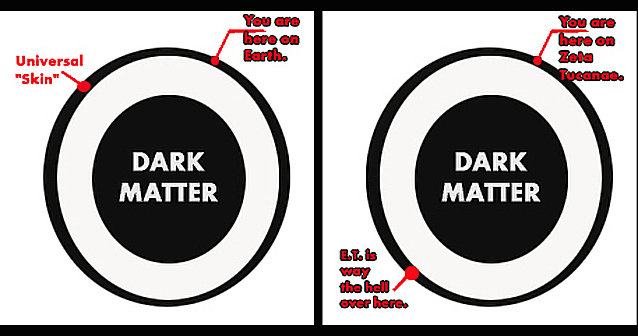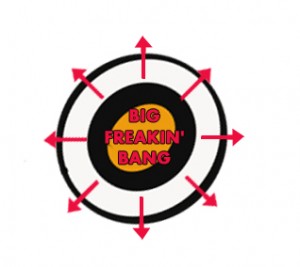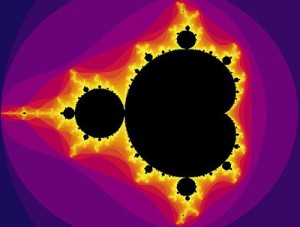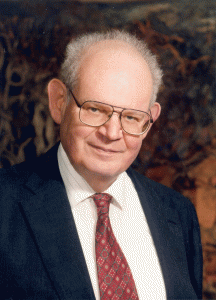
Every year Hollywood gives us at least one movie where our world is greeted, confronted or otherwise engaged with forces not of our earth. It’s a fascinating plot device even though, deep down, I don’t believe we will ever make contact with interstellar life, if there is in fact interstellar life to make contact with. I’ll explain how I’ve come to this personal absolute, but first I need to come clean. This is all speculation based on the minuscule amount of information I know. I am not an astrophysicist although in the next few paragraphs, I will pretend to be. We’ll begin this thought game where we assume it all began.
The Big Bang All was void and emptiness. The point when nothing became something has hounded scientists, theorists and religious scholars for as long as we’ve been here, but science’s generally accepted notion is that somewhere within this nothingness, something occurred, creating the massive universal explosion from which everything began. The stuff of the universe was thrown out into the blackness in all directions with a force, they say, that continues to keep our cosmos expanding. In space there is no direction and no resistance, so that which goes out continues to go out unless there is something in the way to slow it down. If we’re talking about new something exiting into old nothing, then there’s no obstacles.
If something explodes in space and the explosion sends matter in all directions, we’re talking up, down, left, right, toward us and away from us – a spherical trajectory in all directions except inward. Is there something inside, at the point of the initial Big Bang, that even now prevents inward trajectory?
The Spherical Universe If the universe is still expanding, where is it expanding to? It’s really hard for the human mind to conceive of something without a barrier or borderline, but all the top astrophysicists seem to agree that there is no edge, nor a center, to ours. If it is expanding, like a puddle, the only sure way we rate that expansion is by the barriers around it – the width of a street, or a hole, or a field, but there is a physical surround by which we measure the expansion, but that’s if we see the universe as a flat plane, an expanding puddle. We create the understanding by placing things in definable shapes.
The stuff of our world, and understanding thereof, constantly negates the plate-theory of universal form, the natural physicality constantly pointing to spheres and things that orbit around them. Electrons orbit the nucleus. The moon orbits us. We orbit the sun, and all these seem to occur in circular arcs. At the same time, we look at water droplets, soap bubbles, and so much more that automatically takes the form of a circle. The sphere is a perfect, natural shape and if you happen to be living on the sphere itself, you never truly discern an edge even though, theoretically, each one of us is on that edge at all times. It’s not a stretch to think, just maybe, the whole of the universal body is like a surrounding atmosphere. It’s also supported, in part, by the phenomenon of self-similarity, found in fractal geometry and the famed Mandelbrot Set put forth by Benoit Mandelbrot. After mapping his peculiar equation as a graphic he found the shape, like a black beetle, was comprised of smaller versions of the same shape. The deeper you look at the graphic, the parts are revealed to be the same shape in multiples, over and over again. Fractal geometry has been found to explain many natural structures, from the branching of trees to composition of snail shells and so on. It is not too far out to think of atoms, planets, moons, suns and maybe even a much larger unit like a spherical universe, all being a chain of self-similarity. Perhaps Earth is simply another piece of a set that closely resembles that which we already know.
Surrounding What? Only 4.6% of the universe is matter, 23% is the nearly unquantifiable nothing that is called “Dark Matter”, most details of which still fall under the umbrella of speculation. That 4.6% is the stuff cast outward from the Big Bang, creating planets, stars, nebulae, even the elements that make up those things, and as vast as that all is, it accounts for a mere pittance of the “is” that we understand to be. The logic leap then could be that, having decided the stars, planets and all the rest swirls along the skin of this massive soap bubble, all that is inside it is dark matter, and at the center of that is the exact point where the Big Bang initially occurred.
This is a sticky point to make since cosmologists have already decided they know where the point of creation took place, but there is a verisimilitude to how the order of the universe might be in relation to how our own planet’s order is, and how atomic and sub-atomic order is. I may be making a leap, but the patterns do line up. The effect of this is that we’re not plotting charts on a map from point A to point B. In order to grasp what it might take to find intelligent life out there, or for them to find us, it would be like you, dear reader, plotting a course that’s not down the street but on the other side of the planet, but extended more times than imaginable.
What Of The Distance The fourth closest star to Earth is Zeta Tucanae in the Tucana constellation. It is a neighbor to you as your neighbor is four houses, or four apartments, or four streets away from you; relatively close. It would take 28.0 light years to travel from Earth to Zeta Tucanae, or roughly thirty-thousand years traveling at a million miles an hour, so the cake you’re baking with the sugar you’re borrowing from your Zeta neighbors better be damn good. These are big numbers to be tossing about, and big numbers tend to conjure big pictures, so let’s put it on a picture.

(You are here on Earth right now. If you take the trip and are able to make up the necessary speed... You are there on Zeta Tucanae. 30,000 years later and you've barely stuck your head out the window to shout at your neighbor.)
At the same time, because space-time is such an odd, quirky thing, our potential visitors have several bad outcomes if they decide to stop by. They could show up, potentially, before Earth even exists or overshoot our corporeal lifespan entirely, only the radio waves we sent out eons ago alerting them that we ever existed. Bummer.
Black Holes It has been long speculated that black holes and wormholes might be harnessed to get us from here to there, provided we could ever build a craft that could withstand the pressures these phenomena cause, which we never could. Ever. Black holes are super-compact mass that warp the fabric of space-time, creating a vortex from which nothing, not even light, can escape. In a sense, these bodies are fissures in the skin of our soap-bubble universe. It could be said that instead of the common belief, that the gravitational force is so great that all gets destroyed in its wake, it isn’t destroying but transforming the stuff of the cosmos, that puny bit of the 4.6% back into the dark matter from whence it came, channeling it into the center of the bubble, causing the core and the universal skin around it to expand, thus furthering the ever-expanding universe we know. At the same time, there is an elegant commonality to all of it. Man arises from “ashes” then returns to ashes. All that is arises from the blowout of dark matter, becomes stuff essentially composed of the ashes, then returns to the dark matter it sprang from via the black hole. There is a cycle here that ought to be reckoned with.
All this means, in relation to our original question, that with every passing light year, black holes feed the dark matter core, expanding the bubble universe farther and farther. Even if our space-brothers and space-sisters have superior technology, they may well be racing on a highway that’s only getting longer as they run on it. It’s like those primal nightmares everyone have of finishing lines that grow more distant as you race toward them, or staircases that constantly add stairs as you climb them.
Was It Always This Way? If the Earth had sentient life and technology way back at the dawn of man, there is a feasible possibility that the pipsqueak soap bubble universe could have been circled, and it might have only taken a thousand years or so to do it. Smaller roads means less distance to travel. The longer “it” lives, the more “it” expands, the longer it would take, the less likely it would become in spite of advanced technology. Passing through the soap bubble universe wouldn’t work either. If we passed through the Earth, from America to Asia, we could never get near the molten core of the planet, much less penetrate it and pass it by. Even if we could, the gravitational pull would create speeds that would obliterate the craft and us inside it.
Applying the Earth analogy, if a superior technology pierced the soap bubble skin to pass through, that piercing would create an equivalent gravitational pull, except scaled to a massive degree. It would create a black hole that would reduce such spacecraft to dark matter, feeding the core. If the brilliant minds were able to apply ‘slingshot physics’ to their travel, such as the type that helped a disabled Apollo 13 get back home in 1970, by using the opposing forces of the moon’s gravity against the Earth’s to whip the craft around it and back toward Earth’s trajectory, there’s still the problem of time. Yes, they’re going faster, but they’re taking the scenic route to do it.
There’s also a huge problem with my theory in that a few of the best scientific minds currently trying to make sense of it all would never cop to it. Brian Greene, professor at Columbia University, theoretical physicist, author of The Elegant Universe, a treatise on String Theory, and a proponent of mirror symmetry believes in the disc-shaped universe. His idea of the universe having no edge is bolstered by the belief that, in an infinite cosmos, there could never be an edge. You just keep going and going, which is a hard notion for most of us to wrap our heads around. Having spent our adult lives with ends of rooms, roads, continents, and even lives, the thought of a neverending field that only becomes more as you go brings us back to those primal dreams I spoke of earlier.
Here’s the big difference though. I’m putting forward the concept that there may be life out there but their technology, even superior technology, still has billions of variables going against them and the likelihood of them overcoming the variables for a visit is more and more unlikely with every passing minute. The squid people will have to just keep going awhile longer, I suppose. Meanwhile, as a fringe complication of Greene’s mirror symmetry seems to indicate, in an infinite universe there are infinite possibilities of running into ourselves – not just people like us, but us, down to the t-shirt and jeans we’re wearing, the words we’re reading off the computer screen right now, right to the very thoughts in our heads. There’s also a shot at infinite permutations such as all elements are the same except the color of your t-shirt, the ratio of milk in your coffee, in some of these alternate Earths you are the only person there, and in others you’re the only person not there.
This is a severe kick in the crotch to those who believe in the irreducible individuality of the singular person, knowing there might be untold numbers of you’s and me’s all running on the same, or mostly similar, algorithms of action and thought, down to the tiniest synapse-firing. It supports, nonetheless, my assertion that we could never be visited by stating that if it were possible to bridge the immensity of time and space, what we would most often find is us, or a permutation thereof. If we can’t concoct a way to go see them, it is most probable that they cannot concoct a way to see us. Checkmate. (A tip to my universal friends out there reading this, as it has been written by my infinite number of doppelgangers, why don’t you turn off Facebook and go for a bike ride. It’s a nice day out there.)
There is still something comforting in the idea that we’re not looking for our alien neighbors anymore but, in these mirror universes, we are our neighbors. Some of them will make the exact same mistakes we will, some will take a different path and avoid those bumps in the road, but all in all we aren’t alone. Maybe we don’t have to travel out there because we’re already there. I’m personally hoping that, in one of these strange, different mirror-Earths I’m taking Kristen Wiig out to dinner tonight. It can’t happen here, but maybe it can out there.
Science Fiction As a kid, I enjoyed science fiction as much as the next raving geek. Of course, the science fiction we got was more the latter than the former. My obsession with Star Wars didn’t yet diminish under the weight of the facts: no sound in space, a body in motion tends to stay in motion for a hell of a long time and, most importantly, girls simply aren’t interested in dressing in metal bikinis for you. What it did for me, however, was instill in my mind a ‘what-if’ sense of wonder that has served me fairly well.
When confronted with hard numbers though, even with my flights of fancy such as the totality of this speculation was, nothing can fully explain the immenseness, the strangeness, the absolute mystery of this entity we’ve found ourselves in. We may never know if there’s anybody out there, like or unlike us, but our consciousness expands simply by thinking about it, and how could that be a bad thing? And as for my reconciliation of these ideas with the fact that I consider myself a Christian, well, that’s a tale for another day.
__________________________________
I’d like to thank the following for helping me formulate this awful mess:
Wikipedia pages on Apollo 13, dark matter, black holes, and Zeta Tucanae.
Nova Science Now, hosted by Neil DeGrasse Tyson on PBS.
WNYC’s RadioLab hosted by Jad Abumrad and Robert Krulwich, available on most public radio stations and as a podcast via the site or through iTunes.









Comments